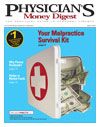Publication
Article
Physician's Money Digest
One Practice's Prescription for EMR Success
Author(s):
The frontlines of health care are small- and medium- sized medical practices that deliver 70% of America's health care. Providers, patients, and the government, together, need to take on responsibility for a much more sophisticated and involved shepherding of health care information storage.
To see the impact that electronic medical records (EMRs) can make on small practices, consider the example of MedPeds, a six-physician adult medicine and pediatrics practice in Laurel, Maryland. This past year, MedPeds made the transition from a practice using paper-based charts to one utilizing EMR technology.
Understandable Hesitation
As physicians all know, many of us are reluctant to adopt EMR if it does not mirror our workflow. An easy-to-use system is key to adoption. MedPeds' head nurse had never used a computer prior to implementation. When MedPeds moved to electronic tablet PCs, the nurse considered retiring because the process overwhelmed her. Within 2 months, however, she became enamored with what she could now do for the patients in her job as a triage nurse. She's now EMR's biggest advocate because of how easy her job became, how quickly she was able to pull information from a patient's electronic record, and how easily her messages transferred from her desk to the physician's desk and back again. A message from a triage nurse now goes to a physician and back an average of 1 day faster.
Chart tacks have been eliminated, and, as a result, employees no longer search throughout the office for patient information. Instead, all necessary employees enjoy instant access to all patient information, which is more accurate, in-depth, and readily available than ever before. Additionally, chart creation time has been reduced to a couple of minutes. This has saved time and money, and the management of all phone calls and messages has greatly improved.
MedPeds found these "soft" benefits invaluable when considering the efficiency increases and flexibility that EMRs gave doctors and nurses. For example, physicians on-call can call up a patient from home on their electronic tablet and immediately view complete patient histories, past visits, current medications, allergies, labs, and charts. The physician can then speak to the patient and send a partner a message about the phone encounter, right to the inbox, so that when the partner comes in Monday morning, the patient can be managed. In this way and many others, an EMR solution helps the practice with continuity of care. Medical reminders and alerts communication, lab tracking, and database management are also distinct advantages, as is the ability to run reports to see trends or quickly view previous patient visits.
Tangible Return on Investment
Streamlined workflow, increased doctor efficiency, clinical data collection, and decision support are all one side of the coin. The other side: While reducing the costs of transcription and staff is helpful, a truly valuable EMR system addresses coding, reimbursement management, and payer interactions to help drive practice profitability. Consider: If your EMR and practice management system pay for itself with increased collections, the practice will be highly motivated to completely adopt the system.
At MedPeds, the EMR technology has reduced nonphysician support staff by 33%. The office overhead for the practice has decreased by about 15%, overdue accounts have decreased by 50%, and income per visit has increased, as doctors have documented more detailed progress notes. Patient volume has increased by 10%, and new patient volume increased by 50%. Return on investment for the EMR is 100% in 1 year.
Meanwhile, patient satisfaction has increased, per managed care patient satisfaction surveys and in patient comments in the office. Patients like the ease of access to their records when they call in for advice from the nurse, the ease of communication with the specialist, prescriptions waiting for them at the pharmacy, and the ease of obtaining accurate information from the doctor on call. Policy makers and the private sector must work together to turn guiding tenets into practical realities.
The Dawn of the Virtual Visit
Today many consumers are clamoring for increased knowledge and empowerment. In this regard, an EMR solution with patient–doctor interaction should be strongly considered. MedPeds is implementing a patient portal, an application that will make the patient experience more pleasant and customer-friendly.
The current paradigm is that information is physician- and telephone-centric; whereas the patient portal is patient- and Web-centric with patients controlling their access to key information: prescriptions, referrals, lab results, and appointments. The elegance of a patient-centric data flow is that it will save physicians money and enhance patient satisfaction. The information patients want to receive and send is integrated with the EMR so that staff time will be saved in patient communications, and the hassle of the customary telephone tag is avoided.
Seth Eaton, MD, is with MedPeds, a six-physician adult medicine and pediatrics practice in Maryland. He utilized EMR technology from eClinicalWorks.
